A Comprehensive Review of Theories, Principles, Models: Education
VerifiedAdded on 2023/01/12
|11
|3264
|30
Report
AI Summary
This report provides a comprehensive overview of theories, principles, and models in education and training. It delves into various learning theories such as behaviorist theory, social development theory, and the emergentist model, along with inductive and deductive approaches. The application of these theories, models, and principles to teaching and assessment is discussed, including the theory of personality, competency-based programs, product-focused techniques, and the experiential learning model. The report also explores models of learning preferences like the Honey Mumford learning style and multiple intelligence theory, explaining how identifying individual learning preferences enables inclusive learning and teaching assessment. Furthermore, it touches upon theories, principles, and models of communication and assessment, including diagnostic, formative, and summative assessment, and concludes with a discussion on reflection and evaluation models, particularly Gibbs' reflective cycle, and their application to reviewing one's own practice. The document is available on Desklib, a platform offering a wealth of study resources for students.
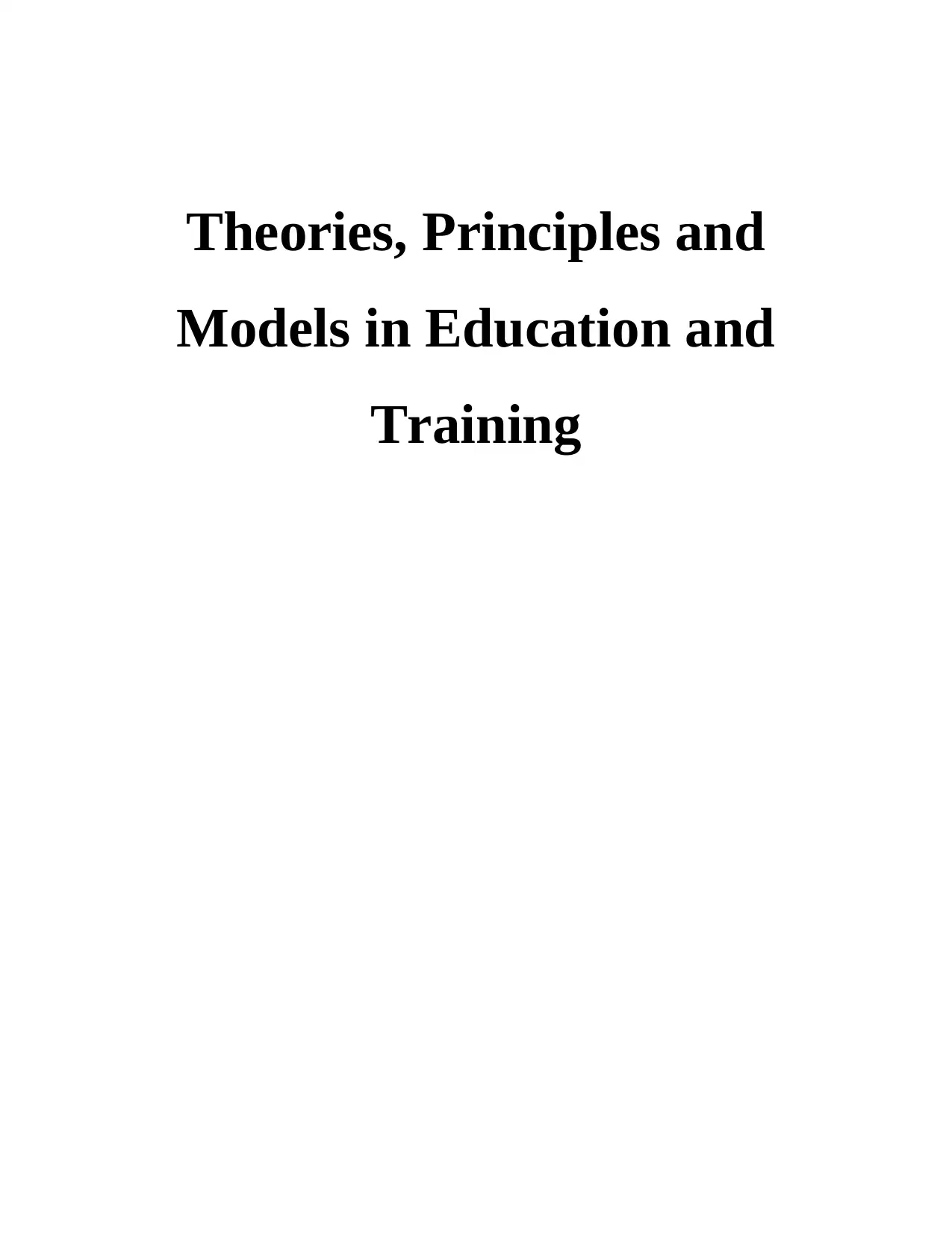
Theories, Principles and
Models in Education and
Training
Models in Education and
Training
Paraphrase This Document
Need a fresh take? Get an instant paraphrase of this document with our AI Paraphraser
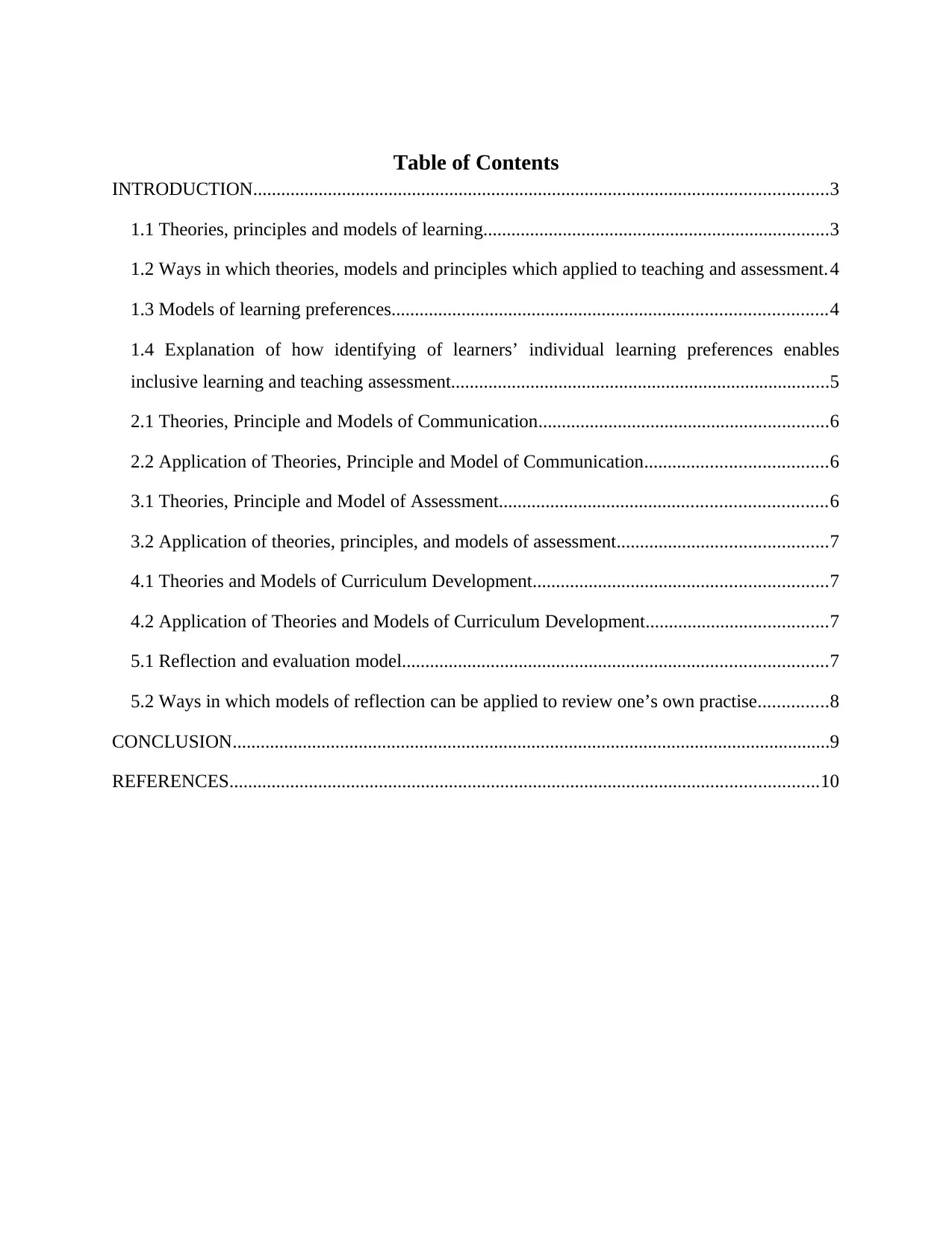
Table of Contents
INTRODUCTION...........................................................................................................................3
1.1 Theories, principles and models of learning..........................................................................3
1.2 Ways in which theories, models and principles which applied to teaching and assessment.4
1.3 Models of learning preferences.............................................................................................4
1.4 Explanation of how identifying of learners’ individual learning preferences enables
inclusive learning and teaching assessment.................................................................................5
2.1 Theories, Principle and Models of Communication..............................................................6
2.2 Application of Theories, Principle and Model of Communication.......................................6
3.1 Theories, Principle and Model of Assessment......................................................................6
3.2 Application of theories, principles, and models of assessment.............................................7
4.1 Theories and Models of Curriculum Development...............................................................7
4.2 Application of Theories and Models of Curriculum Development.......................................7
5.1 Reflection and evaluation model...........................................................................................7
5.2 Ways in which models of reflection can be applied to review one’s own practise...............8
CONCLUSION................................................................................................................................9
REFERENCES..............................................................................................................................10
INTRODUCTION...........................................................................................................................3
1.1 Theories, principles and models of learning..........................................................................3
1.2 Ways in which theories, models and principles which applied to teaching and assessment.4
1.3 Models of learning preferences.............................................................................................4
1.4 Explanation of how identifying of learners’ individual learning preferences enables
inclusive learning and teaching assessment.................................................................................5
2.1 Theories, Principle and Models of Communication..............................................................6
2.2 Application of Theories, Principle and Model of Communication.......................................6
3.1 Theories, Principle and Model of Assessment......................................................................6
3.2 Application of theories, principles, and models of assessment.............................................7
4.1 Theories and Models of Curriculum Development...............................................................7
4.2 Application of Theories and Models of Curriculum Development.......................................7
5.1 Reflection and evaluation model...........................................................................................7
5.2 Ways in which models of reflection can be applied to review one’s own practise...............8
CONCLUSION................................................................................................................................9
REFERENCES..............................................................................................................................10
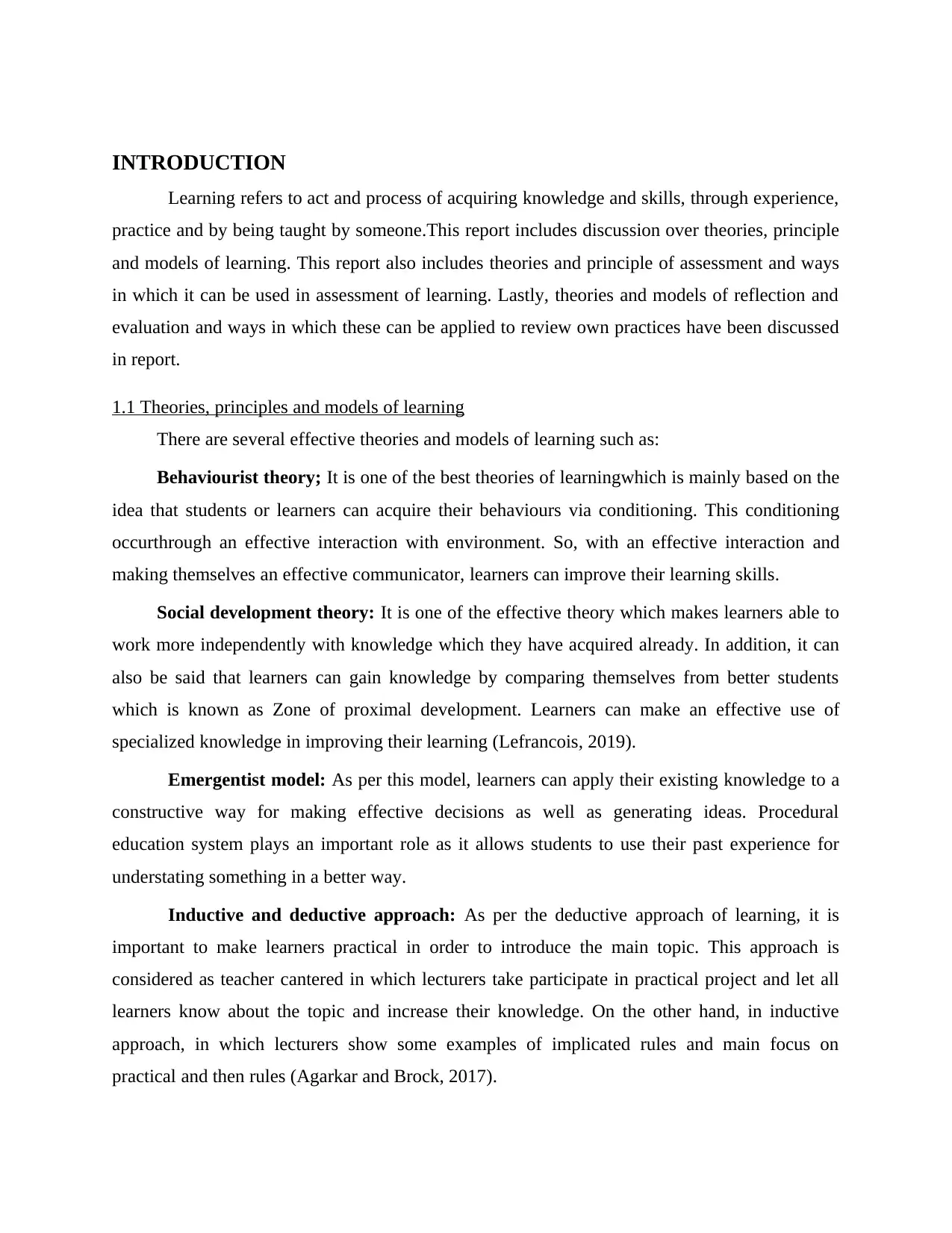
INTRODUCTION
Learning refers to act and process of acquiring knowledge and skills, through experience,
practice and by being taught by someone.This report includes discussion over theories, principle
and models of learning. This report also includes theories and principle of assessment and ways
in which it can be used in assessment of learning. Lastly, theories and models of reflection and
evaluation and ways in which these can be applied to review own practices have been discussed
in report.
1.1 Theories, principles and models of learning
There are several effective theories and models of learning such as:
Behaviourist theory; It is one of the best theories of learningwhich is mainly based on the
idea that students or learners can acquire their behaviours via conditioning. This conditioning
occurthrough an effective interaction with environment. So, with an effective interaction and
making themselves an effective communicator, learners can improve their learning skills.
Social development theory: It is one of the effective theory which makes learners able to
work more independently with knowledge which they have acquired already. In addition, it can
also be said that learners can gain knowledge by comparing themselves from better students
which is known as Zone of proximal development. Learners can make an effective use of
specialized knowledge in improving their learning (Lefrancois, 2019).
Emergentist model: As per this model, learners can apply their existing knowledge to a
constructive way for making effective decisions as well as generating ideas. Procedural
education system plays an important role as it allows students to use their past experience for
understating something in a better way.
Inductive and deductive approach: As per the deductive approach of learning, it is
important to make learners practical in order to introduce the main topic. This approach is
considered as teacher cantered in which lecturers take participate in practical project and let all
learners know about the topic and increase their knowledge. On the other hand, in inductive
approach, in which lecturers show some examples of implicated rules and main focus on
practical and then rules (Agarkar and Brock, 2017).
Learning refers to act and process of acquiring knowledge and skills, through experience,
practice and by being taught by someone.This report includes discussion over theories, principle
and models of learning. This report also includes theories and principle of assessment and ways
in which it can be used in assessment of learning. Lastly, theories and models of reflection and
evaluation and ways in which these can be applied to review own practices have been discussed
in report.
1.1 Theories, principles and models of learning
There are several effective theories and models of learning such as:
Behaviourist theory; It is one of the best theories of learningwhich is mainly based on the
idea that students or learners can acquire their behaviours via conditioning. This conditioning
occurthrough an effective interaction with environment. So, with an effective interaction and
making themselves an effective communicator, learners can improve their learning skills.
Social development theory: It is one of the effective theory which makes learners able to
work more independently with knowledge which they have acquired already. In addition, it can
also be said that learners can gain knowledge by comparing themselves from better students
which is known as Zone of proximal development. Learners can make an effective use of
specialized knowledge in improving their learning (Lefrancois, 2019).
Emergentist model: As per this model, learners can apply their existing knowledge to a
constructive way for making effective decisions as well as generating ideas. Procedural
education system plays an important role as it allows students to use their past experience for
understating something in a better way.
Inductive and deductive approach: As per the deductive approach of learning, it is
important to make learners practical in order to introduce the main topic. This approach is
considered as teacher cantered in which lecturers take participate in practical project and let all
learners know about the topic and increase their knowledge. On the other hand, in inductive
approach, in which lecturers show some examples of implicated rules and main focus on
practical and then rules (Agarkar and Brock, 2017).
⊘ This is a preview!⊘
Do you want full access?
Subscribe today to unlock all pages.

Trusted by 1+ million students worldwide
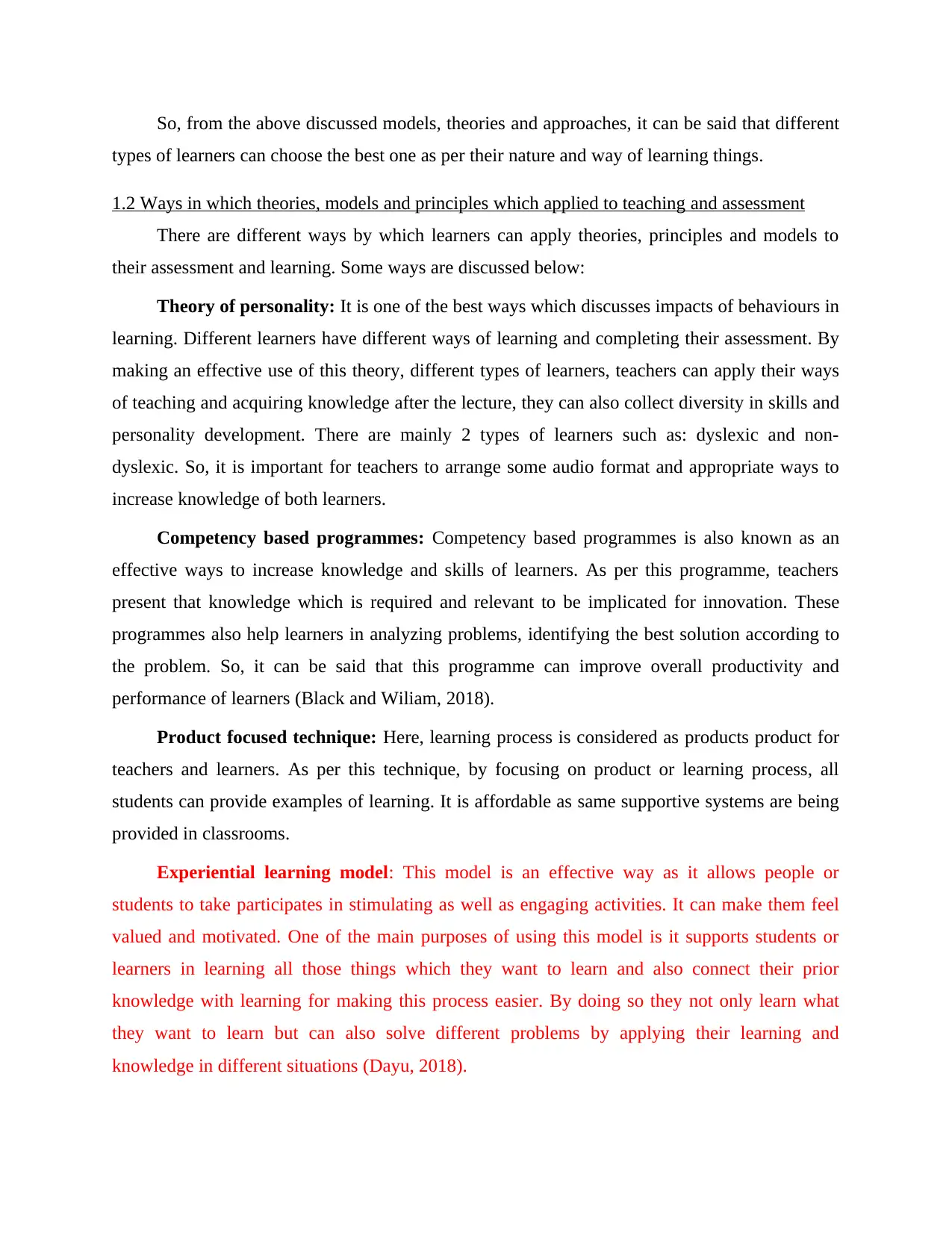
So, from the above discussed models, theories and approaches, it can be said that different
types of learners can choose the best one as per their nature and way of learning things.
1.2 Ways in which theories, models and principles which applied to teaching and assessment
There are different ways by which learners can apply theories, principles and models to
their assessment and learning. Some ways are discussed below:
Theory of personality: It is one of the best ways which discusses impacts of behaviours in
learning. Different learners have different ways of learning and completing their assessment. By
making an effective use of this theory, different types of learners, teachers can apply their ways
of teaching and acquiring knowledge after the lecture, they can also collect diversity in skills and
personality development. There are mainly 2 types of learners such as: dyslexic and non-
dyslexic. So, it is important for teachers to arrange some audio format and appropriate ways to
increase knowledge of both learners.
Competency based programmes: Competency based programmes is also known as an
effective ways to increase knowledge and skills of learners. As per this programme, teachers
present that knowledge which is required and relevant to be implicated for innovation. These
programmes also help learners in analyzing problems, identifying the best solution according to
the problem. So, it can be said that this programme can improve overall productivity and
performance of learners (Black and Wiliam, 2018).
Product focused technique: Here, learning process is considered as products product for
teachers and learners. As per this technique, by focusing on product or learning process, all
students can provide examples of learning. It is affordable as same supportive systems are being
provided in classrooms.
Experiential learning model: This model is an effective way as it allows people or
students to take participates in stimulating as well as engaging activities. It can make them feel
valued and motivated. One of the main purposes of using this model is it supports students or
learners in learning all those things which they want to learn and also connect their prior
knowledge with learning for making this process easier. By doing so they not only learn what
they want to learn but can also solve different problems by applying their learning and
knowledge in different situations (Dayu, 2018).
types of learners can choose the best one as per their nature and way of learning things.
1.2 Ways in which theories, models and principles which applied to teaching and assessment
There are different ways by which learners can apply theories, principles and models to
their assessment and learning. Some ways are discussed below:
Theory of personality: It is one of the best ways which discusses impacts of behaviours in
learning. Different learners have different ways of learning and completing their assessment. By
making an effective use of this theory, different types of learners, teachers can apply their ways
of teaching and acquiring knowledge after the lecture, they can also collect diversity in skills and
personality development. There are mainly 2 types of learners such as: dyslexic and non-
dyslexic. So, it is important for teachers to arrange some audio format and appropriate ways to
increase knowledge of both learners.
Competency based programmes: Competency based programmes is also known as an
effective ways to increase knowledge and skills of learners. As per this programme, teachers
present that knowledge which is required and relevant to be implicated for innovation. These
programmes also help learners in analyzing problems, identifying the best solution according to
the problem. So, it can be said that this programme can improve overall productivity and
performance of learners (Black and Wiliam, 2018).
Product focused technique: Here, learning process is considered as products product for
teachers and learners. As per this technique, by focusing on product or learning process, all
students can provide examples of learning. It is affordable as same supportive systems are being
provided in classrooms.
Experiential learning model: This model is an effective way as it allows people or
students to take participates in stimulating as well as engaging activities. It can make them feel
valued and motivated. One of the main purposes of using this model is it supports students or
learners in learning all those things which they want to learn and also connect their prior
knowledge with learning for making this process easier. By doing so they not only learn what
they want to learn but can also solve different problems by applying their learning and
knowledge in different situations (Dayu, 2018).
Paraphrase This Document
Need a fresh take? Get an instant paraphrase of this document with our AI Paraphraser
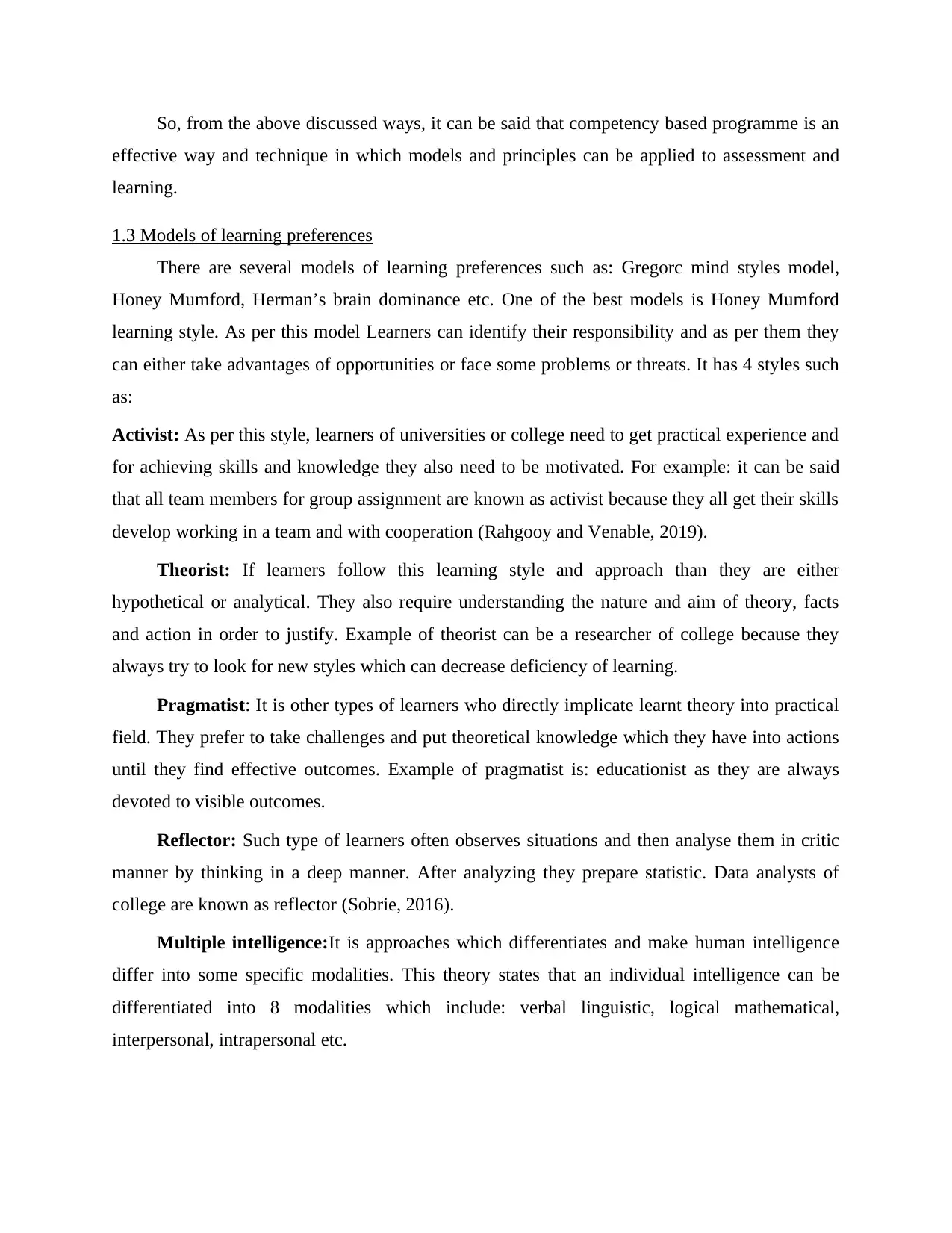
So, from the above discussed ways, it can be said that competency based programme is an
effective way and technique in which models and principles can be applied to assessment and
learning.
1.3 Models of learning preferences
There are several models of learning preferences such as: Gregorc mind styles model,
Honey Mumford, Herman’s brain dominance etc. One of the best models is Honey Mumford
learning style. As per this model Learners can identify their responsibility and as per them they
can either take advantages of opportunities or face some problems or threats. It has 4 styles such
as:
Activist: As per this style, learners of universities or college need to get practical experience and
for achieving skills and knowledge they also need to be motivated. For example: it can be said
that all team members for group assignment are known as activist because they all get their skills
develop working in a team and with cooperation (Rahgooy and Venable, 2019).
Theorist: If learners follow this learning style and approach than they are either
hypothetical or analytical. They also require understanding the nature and aim of theory, facts
and action in order to justify. Example of theorist can be a researcher of college because they
always try to look for new styles which can decrease deficiency of learning.
Pragmatist: It is other types of learners who directly implicate learnt theory into practical
field. They prefer to take challenges and put theoretical knowledge which they have into actions
until they find effective outcomes. Example of pragmatist is: educationist as they are always
devoted to visible outcomes.
Reflector: Such type of learners often observes situations and then analyse them in critic
manner by thinking in a deep manner. After analyzing they prepare statistic. Data analysts of
college are known as reflector (Sobrie, 2016).
Multiple intelligence:It is approaches which differentiates and make human intelligence
differ into some specific modalities. This theory states that an individual intelligence can be
differentiated into 8 modalities which include: verbal linguistic, logical mathematical,
interpersonal, intrapersonal etc.
effective way and technique in which models and principles can be applied to assessment and
learning.
1.3 Models of learning preferences
There are several models of learning preferences such as: Gregorc mind styles model,
Honey Mumford, Herman’s brain dominance etc. One of the best models is Honey Mumford
learning style. As per this model Learners can identify their responsibility and as per them they
can either take advantages of opportunities or face some problems or threats. It has 4 styles such
as:
Activist: As per this style, learners of universities or college need to get practical experience and
for achieving skills and knowledge they also need to be motivated. For example: it can be said
that all team members for group assignment are known as activist because they all get their skills
develop working in a team and with cooperation (Rahgooy and Venable, 2019).
Theorist: If learners follow this learning style and approach than they are either
hypothetical or analytical. They also require understanding the nature and aim of theory, facts
and action in order to justify. Example of theorist can be a researcher of college because they
always try to look for new styles which can decrease deficiency of learning.
Pragmatist: It is other types of learners who directly implicate learnt theory into practical
field. They prefer to take challenges and put theoretical knowledge which they have into actions
until they find effective outcomes. Example of pragmatist is: educationist as they are always
devoted to visible outcomes.
Reflector: Such type of learners often observes situations and then analyse them in critic
manner by thinking in a deep manner. After analyzing they prepare statistic. Data analysts of
college are known as reflector (Sobrie, 2016).
Multiple intelligence:It is approaches which differentiates and make human intelligence
differ into some specific modalities. This theory states that an individual intelligence can be
differentiated into 8 modalities which include: verbal linguistic, logical mathematical,
interpersonal, intrapersonal etc.
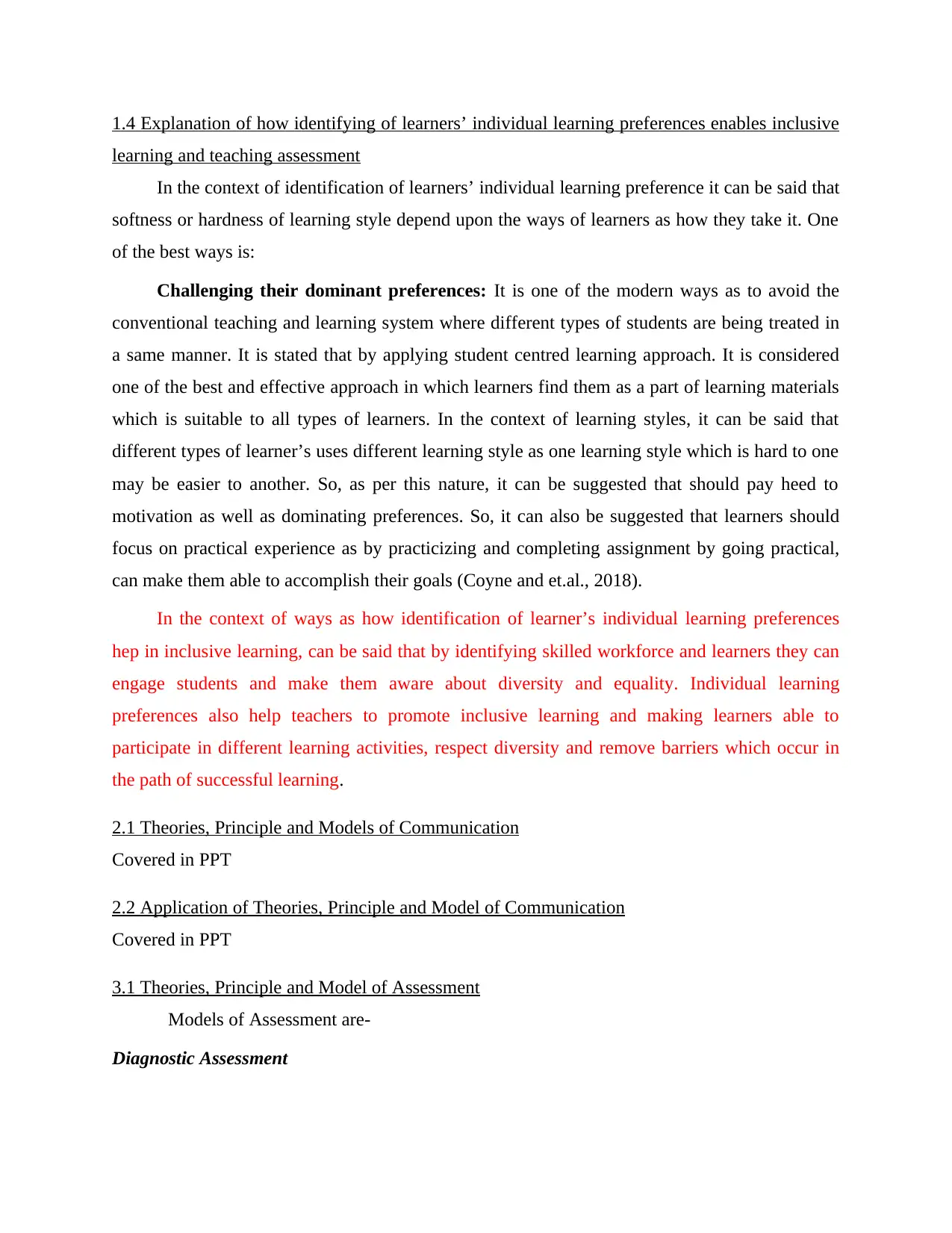
1.4 Explanation of how identifying of learners’ individual learning preferences enables inclusive
learning and teaching assessment
In the context of identification of learners’ individual learning preference it can be said that
softness or hardness of learning style depend upon the ways of learners as how they take it. One
of the best ways is:
Challenging their dominant preferences: It is one of the modern ways as to avoid the
conventional teaching and learning system where different types of students are being treated in
a same manner. It is stated that by applying student centred learning approach. It is considered
one of the best and effective approach in which learners find them as a part of learning materials
which is suitable to all types of learners. In the context of learning styles, it can be said that
different types of learner’s uses different learning style as one learning style which is hard to one
may be easier to another. So, as per this nature, it can be suggested that should pay heed to
motivation as well as dominating preferences. So, it can also be suggested that learners should
focus on practical experience as by practicizing and completing assignment by going practical,
can make them able to accomplish their goals (Coyne and et.al., 2018).
In the context of ways as how identification of learner’s individual learning preferences
hep in inclusive learning, can be said that by identifying skilled workforce and learners they can
engage students and make them aware about diversity and equality. Individual learning
preferences also help teachers to promote inclusive learning and making learners able to
participate in different learning activities, respect diversity and remove barriers which occur in
the path of successful learning.
2.1 Theories, Principle and Models of Communication
Covered in PPT
2.2 Application of Theories, Principle and Model of Communication
Covered in PPT
3.1 Theories, Principle and Model of Assessment
Models of Assessment are-
Diagnostic Assessment
learning and teaching assessment
In the context of identification of learners’ individual learning preference it can be said that
softness or hardness of learning style depend upon the ways of learners as how they take it. One
of the best ways is:
Challenging their dominant preferences: It is one of the modern ways as to avoid the
conventional teaching and learning system where different types of students are being treated in
a same manner. It is stated that by applying student centred learning approach. It is considered
one of the best and effective approach in which learners find them as a part of learning materials
which is suitable to all types of learners. In the context of learning styles, it can be said that
different types of learner’s uses different learning style as one learning style which is hard to one
may be easier to another. So, as per this nature, it can be suggested that should pay heed to
motivation as well as dominating preferences. So, it can also be suggested that learners should
focus on practical experience as by practicizing and completing assignment by going practical,
can make them able to accomplish their goals (Coyne and et.al., 2018).
In the context of ways as how identification of learner’s individual learning preferences
hep in inclusive learning, can be said that by identifying skilled workforce and learners they can
engage students and make them aware about diversity and equality. Individual learning
preferences also help teachers to promote inclusive learning and making learners able to
participate in different learning activities, respect diversity and remove barriers which occur in
the path of successful learning.
2.1 Theories, Principle and Models of Communication
Covered in PPT
2.2 Application of Theories, Principle and Model of Communication
Covered in PPT
3.1 Theories, Principle and Model of Assessment
Models of Assessment are-
Diagnostic Assessment
⊘ This is a preview!⊘
Do you want full access?
Subscribe today to unlock all pages.

Trusted by 1+ million students worldwide
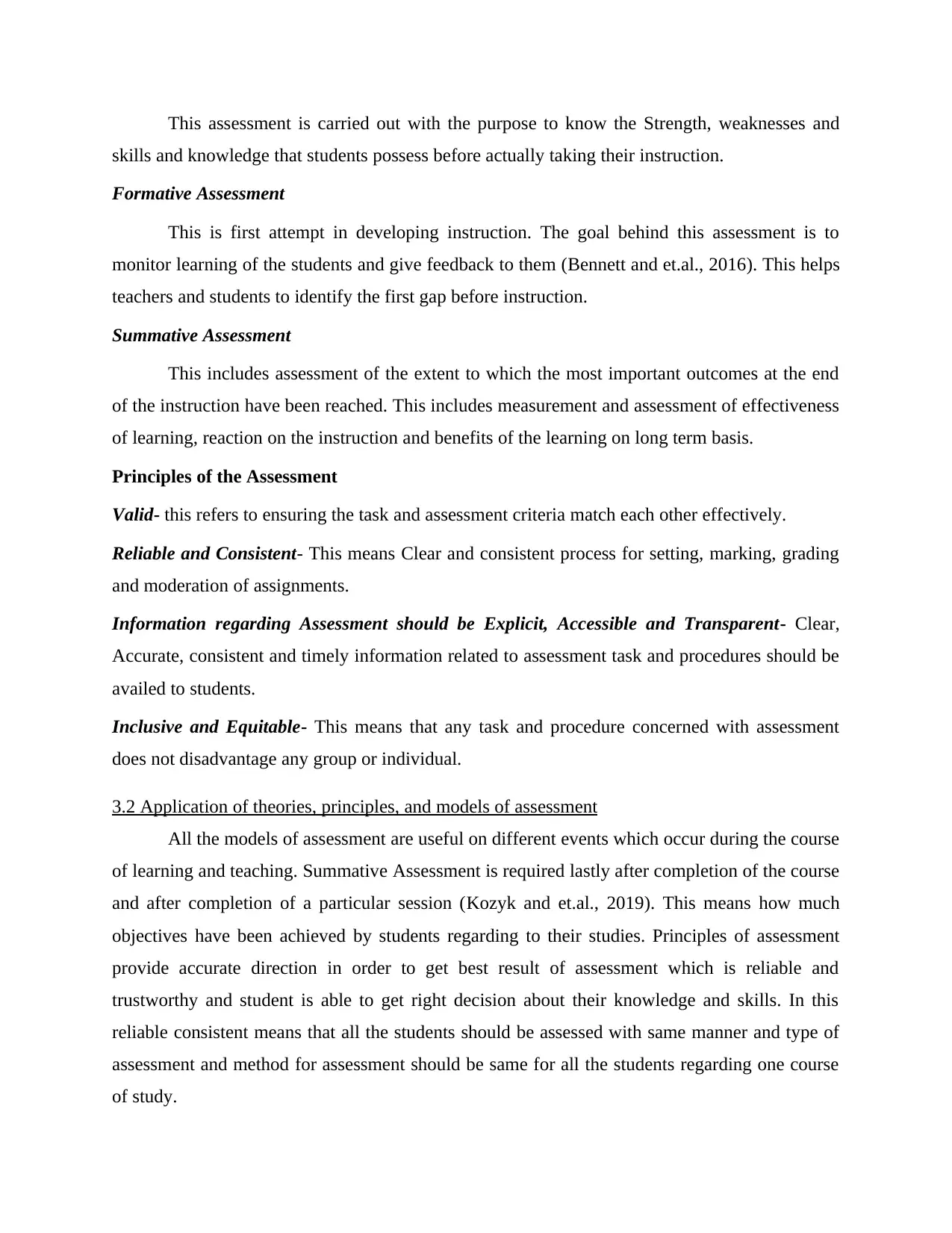
This assessment is carried out with the purpose to know the Strength, weaknesses and
skills and knowledge that students possess before actually taking their instruction.
Formative Assessment
This is first attempt in developing instruction. The goal behind this assessment is to
monitor learning of the students and give feedback to them (Bennett and et.al., 2016). This helps
teachers and students to identify the first gap before instruction.
Summative Assessment
This includes assessment of the extent to which the most important outcomes at the end
of the instruction have been reached. This includes measurement and assessment of effectiveness
of learning, reaction on the instruction and benefits of the learning on long term basis.
Principles of the Assessment
Valid- this refers to ensuring the task and assessment criteria match each other effectively.
Reliable and Consistent- This means Clear and consistent process for setting, marking, grading
and moderation of assignments.
Information regarding Assessment should be Explicit, Accessible and Transparent- Clear,
Accurate, consistent and timely information related to assessment task and procedures should be
availed to students.
Inclusive and Equitable- This means that any task and procedure concerned with assessment
does not disadvantage any group or individual.
3.2 Application of theories, principles, and models of assessment
All the models of assessment are useful on different events which occur during the course
of learning and teaching. Summative Assessment is required lastly after completion of the course
and after completion of a particular session (Kozyk and et.al., 2019). This means how much
objectives have been achieved by students regarding to their studies. Principles of assessment
provide accurate direction in order to get best result of assessment which is reliable and
trustworthy and student is able to get right decision about their knowledge and skills. In this
reliable consistent means that all the students should be assessed with same manner and type of
assessment and method for assessment should be same for all the students regarding one course
of study.
skills and knowledge that students possess before actually taking their instruction.
Formative Assessment
This is first attempt in developing instruction. The goal behind this assessment is to
monitor learning of the students and give feedback to them (Bennett and et.al., 2016). This helps
teachers and students to identify the first gap before instruction.
Summative Assessment
This includes assessment of the extent to which the most important outcomes at the end
of the instruction have been reached. This includes measurement and assessment of effectiveness
of learning, reaction on the instruction and benefits of the learning on long term basis.
Principles of the Assessment
Valid- this refers to ensuring the task and assessment criteria match each other effectively.
Reliable and Consistent- This means Clear and consistent process for setting, marking, grading
and moderation of assignments.
Information regarding Assessment should be Explicit, Accessible and Transparent- Clear,
Accurate, consistent and timely information related to assessment task and procedures should be
availed to students.
Inclusive and Equitable- This means that any task and procedure concerned with assessment
does not disadvantage any group or individual.
3.2 Application of theories, principles, and models of assessment
All the models of assessment are useful on different events which occur during the course
of learning and teaching. Summative Assessment is required lastly after completion of the course
and after completion of a particular session (Kozyk and et.al., 2019). This means how much
objectives have been achieved by students regarding to their studies. Principles of assessment
provide accurate direction in order to get best result of assessment which is reliable and
trustworthy and student is able to get right decision about their knowledge and skills. In this
reliable consistent means that all the students should be assessed with same manner and type of
assessment and method for assessment should be same for all the students regarding one course
of study.
Paraphrase This Document
Need a fresh take? Get an instant paraphrase of this document with our AI Paraphraser
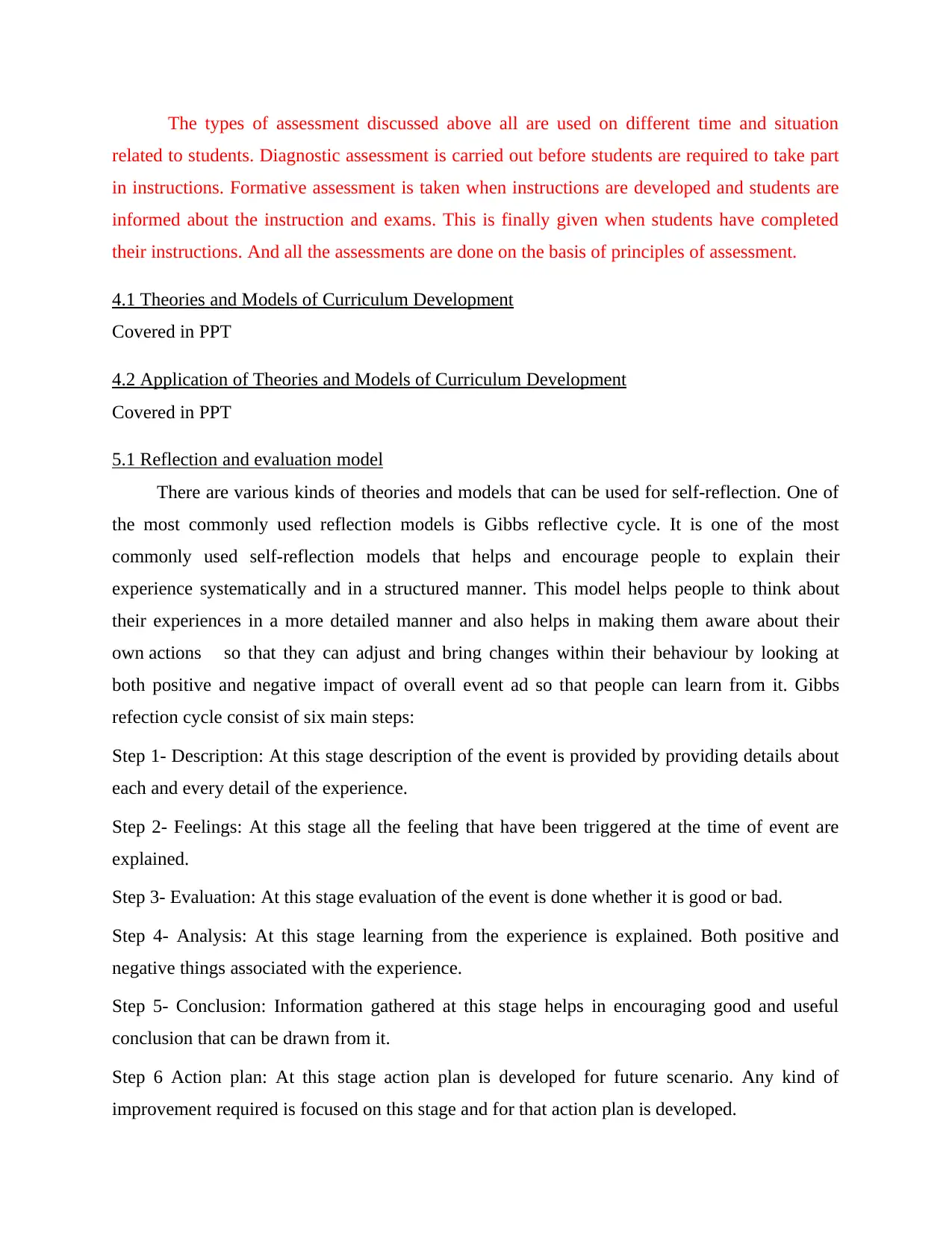
The types of assessment discussed above all are used on different time and situation
related to students. Diagnostic assessment is carried out before students are required to take part
in instructions. Formative assessment is taken when instructions are developed and students are
informed about the instruction and exams. This is finally given when students have completed
their instructions. And all the assessments are done on the basis of principles of assessment.
4.1 Theories and Models of Curriculum Development
Covered in PPT
4.2 Application of Theories and Models of Curriculum Development
Covered in PPT
5.1 Reflection and evaluation model
There are various kinds of theories and models that can be used for self-reflection. One of
the most commonly used reflection models is Gibbs reflective cycle. It is one of the most
commonly used self-reflection models that helps and encourage people to explain their
experience systematically and in a structured manner. This model helps people to think about
their experiences in a more detailed manner and also helps in making them aware about their
own actions so that they can adjust and bring changes within their behaviour by looking at
both positive and negative impact of overall event ad so that people can learn from it. Gibbs
refection cycle consist of six main steps:
Step 1- Description: At this stage description of the event is provided by providing details about
each and every detail of the experience.
Step 2- Feelings: At this stage all the feeling that have been triggered at the time of event are
explained.
Step 3- Evaluation: At this stage evaluation of the event is done whether it is good or bad.
Step 4- Analysis: At this stage learning from the experience is explained. Both positive and
negative things associated with the experience.
Step 5- Conclusion: Information gathered at this stage helps in encouraging good and useful
conclusion that can be drawn from it.
Step 6 Action plan: At this stage action plan is developed for future scenario. Any kind of
improvement required is focused on this stage and for that action plan is developed.
related to students. Diagnostic assessment is carried out before students are required to take part
in instructions. Formative assessment is taken when instructions are developed and students are
informed about the instruction and exams. This is finally given when students have completed
their instructions. And all the assessments are done on the basis of principles of assessment.
4.1 Theories and Models of Curriculum Development
Covered in PPT
4.2 Application of Theories and Models of Curriculum Development
Covered in PPT
5.1 Reflection and evaluation model
There are various kinds of theories and models that can be used for self-reflection. One of
the most commonly used reflection models is Gibbs reflective cycle. It is one of the most
commonly used self-reflection models that helps and encourage people to explain their
experience systematically and in a structured manner. This model helps people to think about
their experiences in a more detailed manner and also helps in making them aware about their
own actions so that they can adjust and bring changes within their behaviour by looking at
both positive and negative impact of overall event ad so that people can learn from it. Gibbs
refection cycle consist of six main steps:
Step 1- Description: At this stage description of the event is provided by providing details about
each and every detail of the experience.
Step 2- Feelings: At this stage all the feeling that have been triggered at the time of event are
explained.
Step 3- Evaluation: At this stage evaluation of the event is done whether it is good or bad.
Step 4- Analysis: At this stage learning from the experience is explained. Both positive and
negative things associated with the experience.
Step 5- Conclusion: Information gathered at this stage helps in encouraging good and useful
conclusion that can be drawn from it.
Step 6 Action plan: At this stage action plan is developed for future scenario. Any kind of
improvement required is focused on this stage and for that action plan is developed.
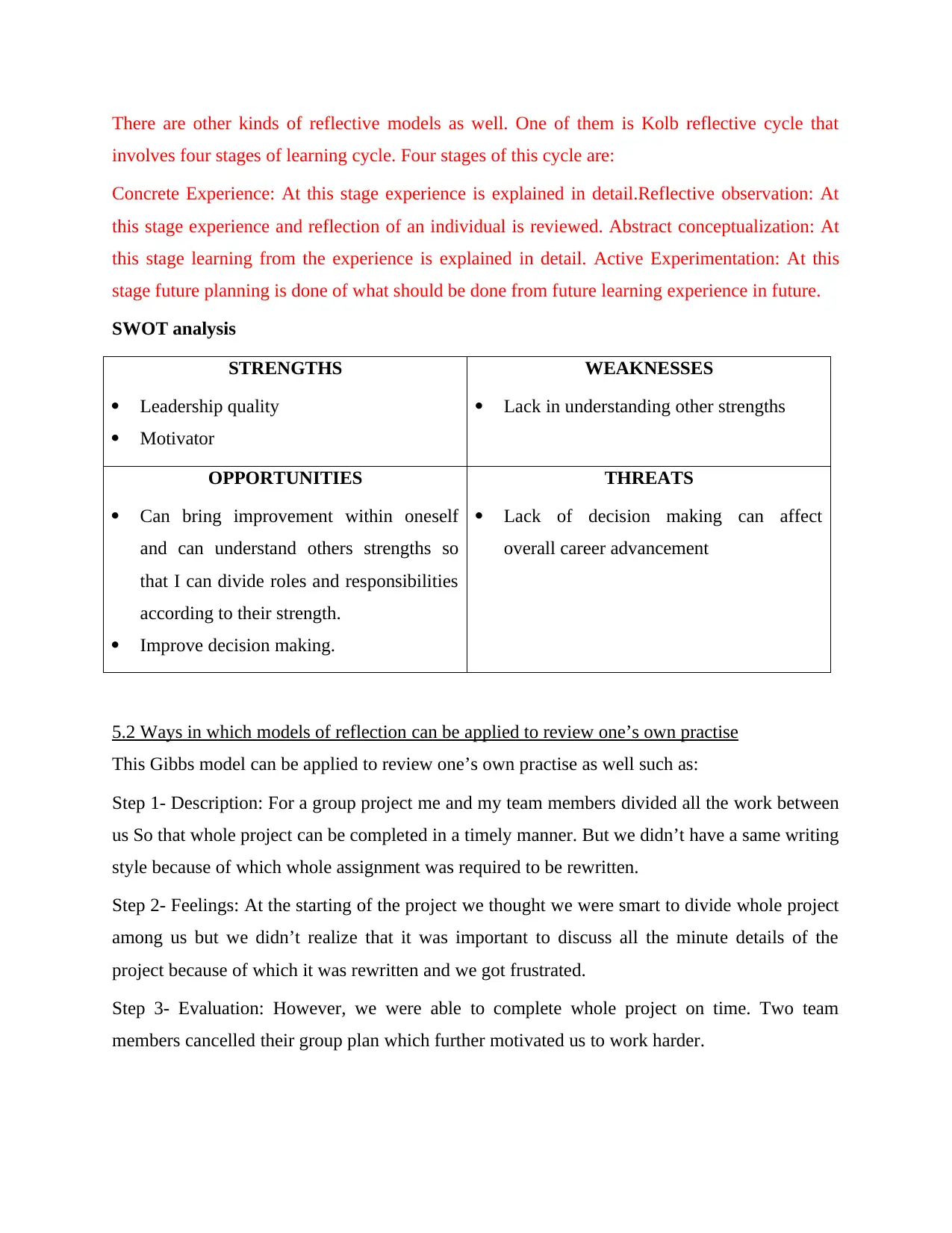
There are other kinds of reflective models as well. One of them is Kolb reflective cycle that
involves four stages of learning cycle. Four stages of this cycle are:
Concrete Experience: At this stage experience is explained in detail.Reflective observation: At
this stage experience and reflection of an individual is reviewed. Abstract conceptualization: At
this stage learning from the experience is explained in detail. Active Experimentation: At this
stage future planning is done of what should be done from future learning experience in future.
SWOT analysis
STRENGTHS
Leadership quality
Motivator
WEAKNESSES
Lack in understanding other strengths
OPPORTUNITIES
Can bring improvement within oneself
and can understand others strengths so
that I can divide roles and responsibilities
according to their strength.
Improve decision making.
THREATS
Lack of decision making can affect
overall career advancement
5.2 Ways in which models of reflection can be applied to review one’s own practise
This Gibbs model can be applied to review one’s own practise as well such as:
Step 1- Description: For a group project me and my team members divided all the work between
us So that whole project can be completed in a timely manner. But we didn’t have a same writing
style because of which whole assignment was required to be rewritten.
Step 2- Feelings: At the starting of the project we thought we were smart to divide whole project
among us but we didn’t realize that it was important to discuss all the minute details of the
project because of which it was rewritten and we got frustrated.
Step 3- Evaluation: However, we were able to complete whole project on time. Two team
members cancelled their group plan which further motivated us to work harder.
involves four stages of learning cycle. Four stages of this cycle are:
Concrete Experience: At this stage experience is explained in detail.Reflective observation: At
this stage experience and reflection of an individual is reviewed. Abstract conceptualization: At
this stage learning from the experience is explained in detail. Active Experimentation: At this
stage future planning is done of what should be done from future learning experience in future.
SWOT analysis
STRENGTHS
Leadership quality
Motivator
WEAKNESSES
Lack in understanding other strengths
OPPORTUNITIES
Can bring improvement within oneself
and can understand others strengths so
that I can divide roles and responsibilities
according to their strength.
Improve decision making.
THREATS
Lack of decision making can affect
overall career advancement
5.2 Ways in which models of reflection can be applied to review one’s own practise
This Gibbs model can be applied to review one’s own practise as well such as:
Step 1- Description: For a group project me and my team members divided all the work between
us So that whole project can be completed in a timely manner. But we didn’t have a same writing
style because of which whole assignment was required to be rewritten.
Step 2- Feelings: At the starting of the project we thought we were smart to divide whole project
among us but we didn’t realize that it was important to discuss all the minute details of the
project because of which it was rewritten and we got frustrated.
Step 3- Evaluation: However, we were able to complete whole project on time. Two team
members cancelled their group plan which further motivated us to work harder.
⊘ This is a preview!⊘
Do you want full access?
Subscribe today to unlock all pages.

Trusted by 1+ million students worldwide
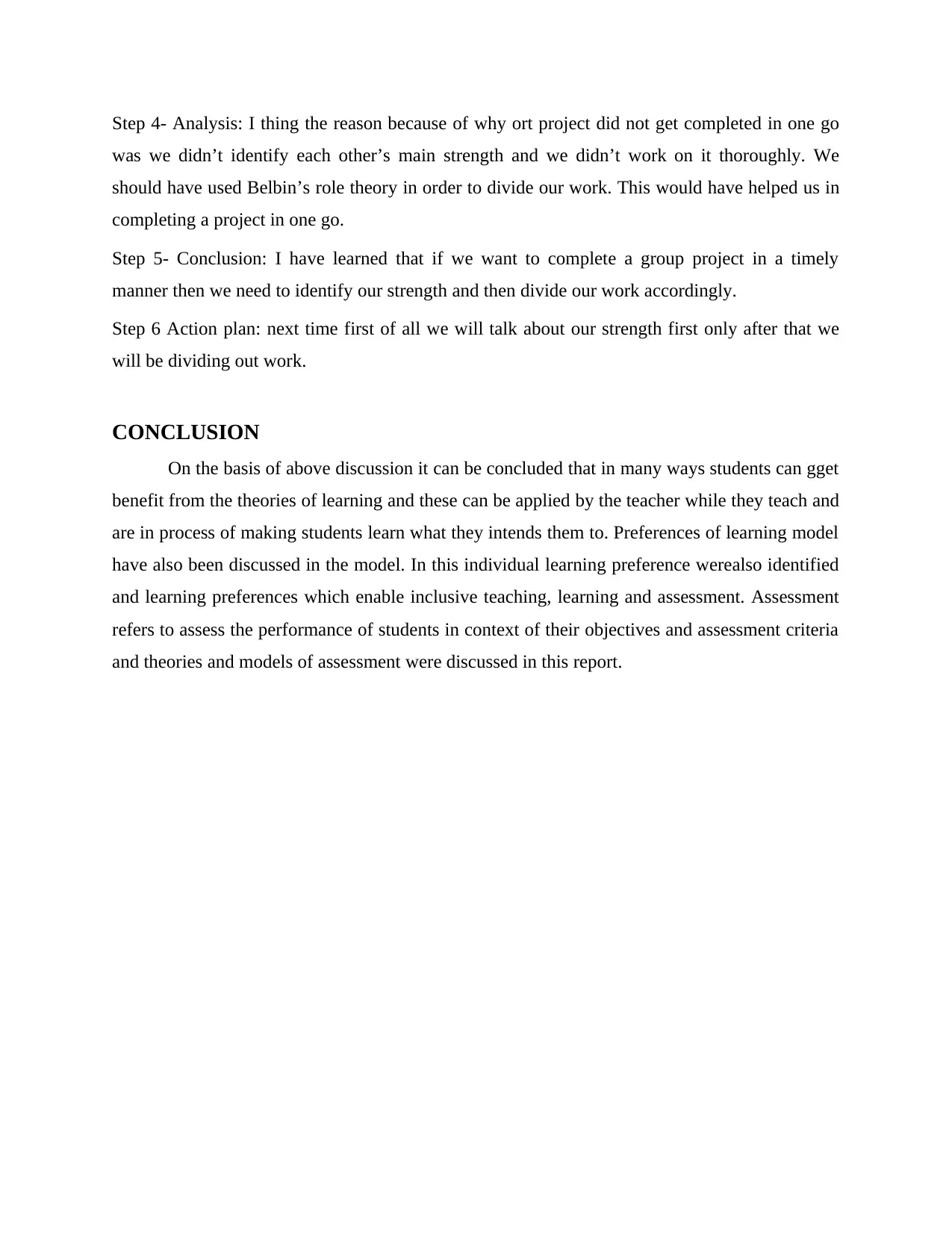
Step 4- Analysis: I thing the reason because of why ort project did not get completed in one go
was we didn’t identify each other’s main strength and we didn’t work on it thoroughly. We
should have used Belbin’s role theory in order to divide our work. This would have helped us in
completing a project in one go.
Step 5- Conclusion: I have learned that if we want to complete a group project in a timely
manner then we need to identify our strength and then divide our work accordingly.
Step 6 Action plan: next time first of all we will talk about our strength first only after that we
will be dividing out work.
CONCLUSION
On the basis of above discussion it can be concluded that in many ways students can gget
benefit from the theories of learning and these can be applied by the teacher while they teach and
are in process of making students learn what they intends them to. Preferences of learning model
have also been discussed in the model. In this individual learning preference werealso identified
and learning preferences which enable inclusive teaching, learning and assessment. Assessment
refers to assess the performance of students in context of their objectives and assessment criteria
and theories and models of assessment were discussed in this report.
was we didn’t identify each other’s main strength and we didn’t work on it thoroughly. We
should have used Belbin’s role theory in order to divide our work. This would have helped us in
completing a project in one go.
Step 5- Conclusion: I have learned that if we want to complete a group project in a timely
manner then we need to identify our strength and then divide our work accordingly.
Step 6 Action plan: next time first of all we will talk about our strength first only after that we
will be dividing out work.
CONCLUSION
On the basis of above discussion it can be concluded that in many ways students can gget
benefit from the theories of learning and these can be applied by the teacher while they teach and
are in process of making students learn what they intends them to. Preferences of learning model
have also been discussed in the model. In this individual learning preference werealso identified
and learning preferences which enable inclusive teaching, learning and assessment. Assessment
refers to assess the performance of students in context of their objectives and assessment criteria
and theories and models of assessment were discussed in this report.
Paraphrase This Document
Need a fresh take? Get an instant paraphrase of this document with our AI Paraphraser
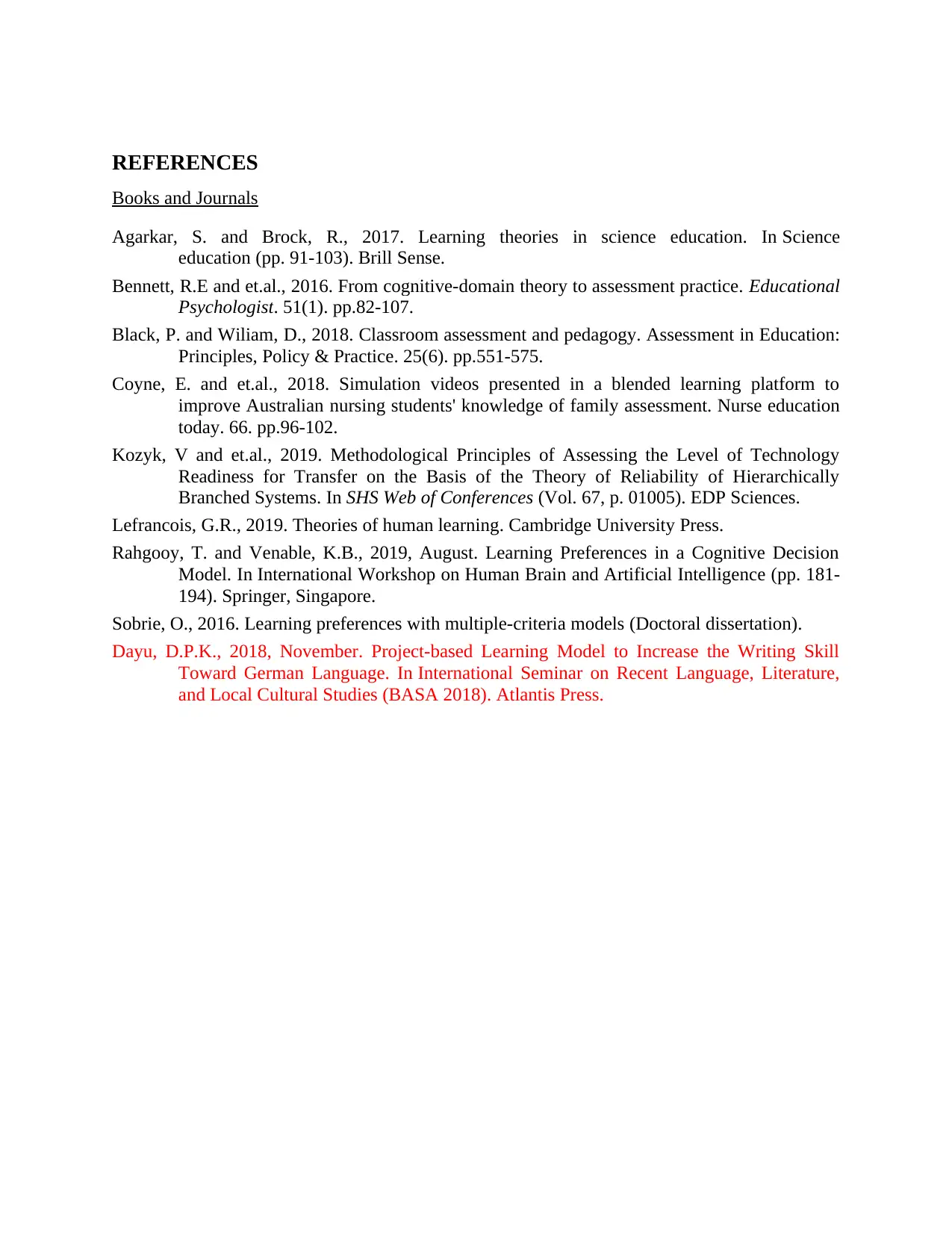
REFERENCES
Books and Journals
Agarkar, S. and Brock, R., 2017. Learning theories in science education. In Science
education (pp. 91-103). Brill Sense.
Bennett, R.E and et.al., 2016. From cognitive-domain theory to assessment practice. Educational
Psychologist. 51(1). pp.82-107.
Black, P. and Wiliam, D., 2018. Classroom assessment and pedagogy. Assessment in Education:
Principles, Policy & Practice. 25(6). pp.551-575.
Coyne, E. and et.al., 2018. Simulation videos presented in a blended learning platform to
improve Australian nursing students' knowledge of family assessment. Nurse education
today. 66. pp.96-102.
Kozyk, V and et.al., 2019. Methodological Principles of Assessing the Level of Technology
Readiness for Transfer on the Basis of the Theory of Reliability of Hierarchically
Branched Systems. In SHS Web of Conferences (Vol. 67, p. 01005). EDP Sciences.
Lefrancois, G.R., 2019. Theories of human learning. Cambridge University Press.
Rahgooy, T. and Venable, K.B., 2019, August. Learning Preferences in a Cognitive Decision
Model. In International Workshop on Human Brain and Artificial Intelligence (pp. 181-
194). Springer, Singapore.
Sobrie, O., 2016. Learning preferences with multiple-criteria models (Doctoral dissertation).
Dayu, D.P.K., 2018, November. Project-based Learning Model to Increase the Writing Skill
Toward German Language. In International Seminar on Recent Language, Literature,
and Local Cultural Studies (BASA 2018). Atlantis Press.
Books and Journals
Agarkar, S. and Brock, R., 2017. Learning theories in science education. In Science
education (pp. 91-103). Brill Sense.
Bennett, R.E and et.al., 2016. From cognitive-domain theory to assessment practice. Educational
Psychologist. 51(1). pp.82-107.
Black, P. and Wiliam, D., 2018. Classroom assessment and pedagogy. Assessment in Education:
Principles, Policy & Practice. 25(6). pp.551-575.
Coyne, E. and et.al., 2018. Simulation videos presented in a blended learning platform to
improve Australian nursing students' knowledge of family assessment. Nurse education
today. 66. pp.96-102.
Kozyk, V and et.al., 2019. Methodological Principles of Assessing the Level of Technology
Readiness for Transfer on the Basis of the Theory of Reliability of Hierarchically
Branched Systems. In SHS Web of Conferences (Vol. 67, p. 01005). EDP Sciences.
Lefrancois, G.R., 2019. Theories of human learning. Cambridge University Press.
Rahgooy, T. and Venable, K.B., 2019, August. Learning Preferences in a Cognitive Decision
Model. In International Workshop on Human Brain and Artificial Intelligence (pp. 181-
194). Springer, Singapore.
Sobrie, O., 2016. Learning preferences with multiple-criteria models (Doctoral dissertation).
Dayu, D.P.K., 2018, November. Project-based Learning Model to Increase the Writing Skill
Toward German Language. In International Seminar on Recent Language, Literature,
and Local Cultural Studies (BASA 2018). Atlantis Press.
1 out of 11
Related Documents
Your All-in-One AI-Powered Toolkit for Academic Success.
+13062052269
info@desklib.com
Available 24*7 on WhatsApp / Email
![[object Object]](/_next/static/media/star-bottom.7253800d.svg)
Unlock your academic potential
Copyright © 2020–2025 A2Z Services. All Rights Reserved. Developed and managed by ZUCOL.




